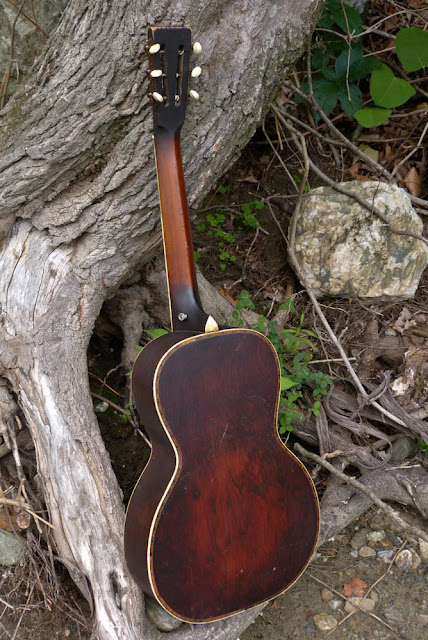1920s Regal-made Lyra Parlor Guitar
A friend of mine sent this poor thing to me as a possible salvage job for him. I knew it wouldn't really be what he wanted, anyhow, and took it in trade during another deal of ours. I figured I could "at least use the neck for something," as the body had no back bracing, wide-open seams, a pulled-off bridge, and... of course... the cool (or horrid) hole to the bass side of the bridge area on the lower bout.
I got to looking at the guitar the other day and decided to just "do it up" in a minimal-hours-invested sort of way. The back was clamped back up, the missing braces replaced with simple "flat stock" soundboard cedar, the bridge got a reglue and new fret saddle, and the frets got some "fudging" (update: that reads as reseating and adjusting heights at the same time to a minor degree) and a level/dress.
I knew the bracing wasn't tough enough to really support steel (it has one brace under the soundhole and one bridge plate/brace at the bridge), but I knew it'd sound pretty good with nylon, so that's what it's strung with. It sounds in some ways an awful lot like a Goya G-10 (both are spruce tops over birch back/sides), but a bit mellower and with a bit less volume -- which is not surprisingly when you consider this is roughly 0-size at 13" on the lower bout.
Playability is right-on for classical at 3/32" at the 12th fret, though the neck profile is a big, hard V-shape that some folks might consider a bit much. Matched with the narrower-than-classical string spacing, however, I have to admit that I like it.
The "Oscar Schmidt Stella-style" bluesy sunburst effect clearly places this in 1920s manufacture, but the design elements force it to the earlier part of that period, to my eye. It's an instrument that was certainly made by Regal, though the branding at the headstock is "Lyra" and it sports a Lyon & Healy-style "flattened-pyramid" bridge.
I think it's fairly obvious that this guitar has had a rough life, though for serious injury it only has a couple hairline back cracks, that stabilized "2nd soundhole," and missing purfling/binding to really show for it. I didn't even need to do a neck set on it to re-use the original bridge at almost full height.
The guitar also got a set of replacement (Harmony, 50s) tuners and a new bone nut.
The stained-maple fretboard is bound and I added side dots, too.
I like how the rosette has just one "tooth" of binding left to it.
The original bridge is a Lyon & Healy-style "flattened-pyramid" type and made from the usual stained maple. I'm used to seeing this on earlier Regals (1900-1915) but not on 20s models, so much, where it seemed to have mostly moved-on to only being used on L&H's house-brand American Conservatory and Washburn instruments. It's no secret, however, that Regal made a lot of their production.
The pins are vintage replacements from my parts-bins.
The "great hole" was too good to cover-up and remove. I glued-up its split edges and I have full faith that it's not an issue except for the cool/uncool factor. You decide on that, but I like it. Someone obviously bumped it really hard on something sharp.
I always prefer the jealous wife/girlfriend story, on these occasions.
I added a "vintaged" strap button because -- you know -- doesn't this look like something to busk with?
The neck is poplar.
A large swath of purfling is missing from the back edge, here.
The back and sides are solid birch and the ruddy-brown finishing job is clearly a market-reach towards OS-made Stella instruments which favored much of the same look.
The original tuners were shot, so I used some old 50s-issue Harmony-style tuners from my parts-bins. They look more-or-less right from a short distance.
The endpin is original.






















Comments
That guitar appears in the book about Regal guitars (forget the name of it) with a color reproduction from the 1928 Regal catalog (Style 2018). In that photo it also has the 'cut off' pyramid bridge. I know because I owned one along with a 1/2 sized (Gertz sized?) Lyra with the same coloring and purfling. So definitely c.1928. Regards Charlie